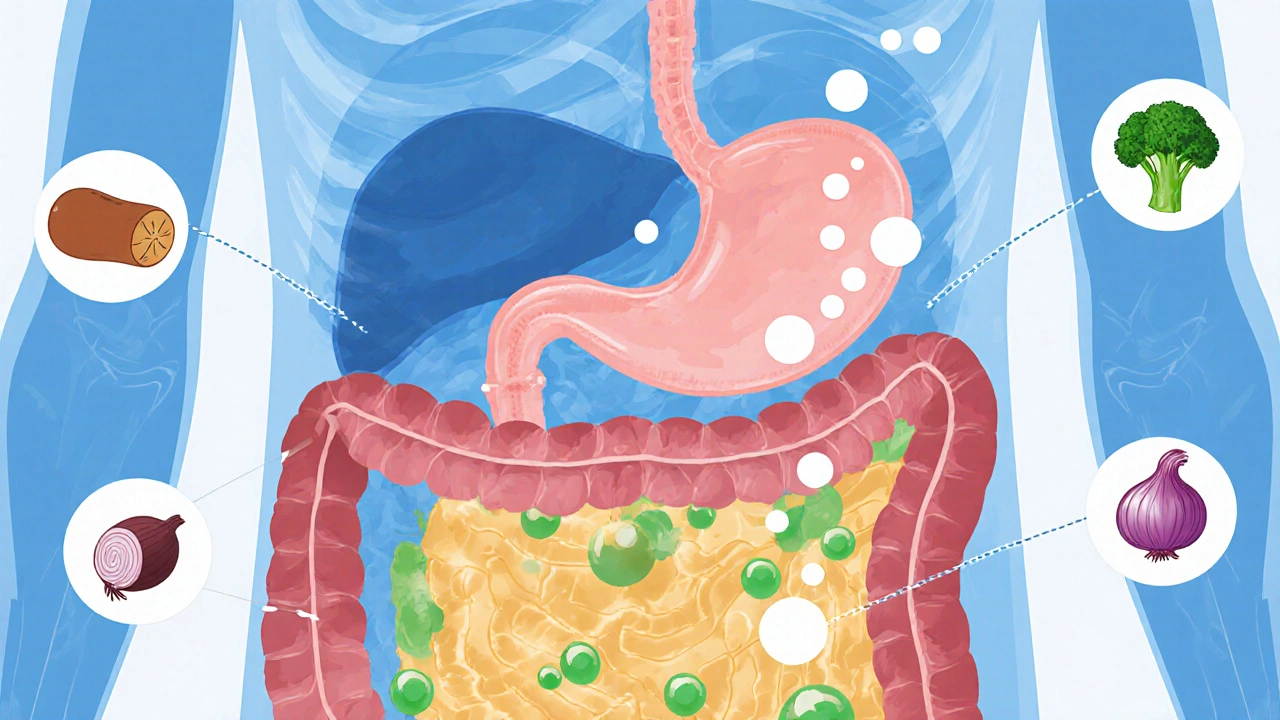10 Oct 2025
- 12 Comments
Flatulence Symptom Checker
Your Assessment Results
Key Takeaways
- Flatulence is the release of excess gas from the digestive tract, often caused by diet, swallowed air, or gut imbalances.
- Frequent bloating, abdominal pain, or sudden odor changes can signal underlying issues such as IBS or lactose intolerance.
- Simple lifestyle tweaks-like slower eating, low‑FODMAP foods, and regular movement-fix 70% of cases.
- When diet alone isn’t enough, probiotics, digestive enzymes, or prescription antispasmodics can provide relief.
- Seek medical advice if gas comes with unexplained weight loss, persistent diarrhea, or severe pain.
What Is Flatulence?
Flatulence is a normal bodily function that involves the expulsion of gas built up in the gastrointestinal tract. While everyone experiences it, the volume, odor, and frequency can vary widely.
If you’re dealing with flatulence, it’s usually a sign that something in your digestive system is out of balance, not a sign of serious disease.
How Gas Forms: The Science Behind Intestinal Gas
Intestinal gas originates from two key sources: swallowed air (aerophagia) and the fermentation of undigested food by gut microbes. Air swallowed while chewing gum, drinking carbonated beverages, or talking while eating can add up to 500ml of gas per day.
Fermentation happens primarily in the colon, where bacteria break down carbohydrates that the small intestine couldn’t absorb. This process releases hydrogen, methane, carbon‑dioxide, and, in smaller amounts, sulfur compounds-the culprits behind the characteristic smell.

Common Triggers and Causes
Understanding the root cause helps you target the right solution. Below are the most frequent contributors:
- Dietary choices: High‑FODMAP foods (e.g., beans, onions, garlic, broccoli, wheat, and certain fruits) are rich in fermentable sugars that fuel gas production.
- Swallowed air: Eating too quickly, using a straw, or smoking increases aerophagia.
- Gut microbiome imbalance: Overgrowth of gas‑producing bacteria can tip the scale.
- Medical conditions: Irritable bowel syndrome (IBS), lactose intolerance, and small intestine bacterial overgrowth (SIBO) are all linked to excess gas.
- Medications: Antibiotics disrupt the normal flora, while some pain relievers slow gut motility, both increasing gas.
Symptoms to Watch For
Flatulence itself is a symptom, but it often co‑exists with other signs that hint at the underlying cause.
- Bloating: A feeling of fullness or distention in the abdomen.
- Abdominal cramping or sharp pain that eases after passing gas.
- Frequent belching in addition to rectal gas release.
- Changes in stool consistency-diarrhea, constipation, or alternating patterns.
- Unusual odor, especially if it’s sulfuric (rotten‑egg smell).
If any of these symptoms appear suddenly, intensify, or accompany weight loss, fever, or blood in stool, it’s time to see a healthcare professional.
Diagnosing the Source
Doctors typically start with a detailed diet and symptom diary. This helps identify patterns-like spikes after dairy or beans.
Additional tests may include:
- Breath tests for lactose intolerance or SIBO.
- Stool analysis to check for infections or dysbiosis.
- Blood work to rule out celiac disease or inflammatory bowel disease.
Most of the time, a thorough history is enough to guide treatment.

Treatment Options: What Works and When
Below is a quick‑reference table that compares the most common interventions.
| Option | Effectiveness (average) | Typical Use | Potential Side Effects |
|---|---|---|---|
| Low‑FODMAP diet | 70‑80% | Reduce fermentable carbs for 4‑6 weeks | Temporary fiber reduction, possible constipation |
| Probiotics | 40‑60% | Daily supplement of Lactobacillus&Bifidobacterium strains | Mild gas increase initially, rare allergic reaction |
| Digestive enzymes (e.g., lactase) | 55‑70% | Taken with meals containing lactose or complex carbs | Usually none, may cause mild nausea if overdosed |
| OTC simethicone | 30‑50% | After meals to coalesce bubbles | Generally well‑tolerated, rare constipation |
| Prescription antispasmodics (e.g., hyoscine) | 60‑75% | For IBS‑related cramping and gas | Drowsiness, dry mouth, blurred vision |
Most people find relief by starting with diet tweaks, then adding probiotics or enzymes as needed. Simethicone offers quick, short‑term comfort, while prescription meds are reserved for chronic, severe cases.
Practical Lifestyle Tips
- Eat mindfully: Chew slowly, put the fork down between bites, and avoid talking while chewing.
- Limit carbonated drinks: Choose still water or herbal teas instead.
- Identify trigger foods: Use a 2‑week food‑symptom journal; flag any meals that cause a noticeable gas surge.
- Stay active: A 20‑minute walk after meals stimulates gut motility and reduces buildup.
- Consider a low‑FODMAP trial: Gradually re‑introduce foods to pinpoint the most problematic ones.
When to See a Healthcare Professional
Most flatulence resolves with self‑care, but schedule a visit if you notice any of the following red flags:
- Sudden, severe abdominal pain that isn’t relieved by passing gas.
- Unexplained weight loss or loss of appetite.
- Persistent diarrhea or constipation lasting more than three weeks.
- Blood or mucus in stool.
- Nighttime gas that wakes you up regularly.
These symptoms could indicate conditions such as inflammatory bowel disease, colorectal cancer, or a serious infection, which require prompt evaluation.
Frequently Asked Questions
Why does my gas smell worse after eating certain foods?
Sulfur‑rich foods like broccoli, cabbage, eggs, and meat release hydrogen sulfide during fermentation, which gives gas a rotten‑egg odor. Reducing these foods or pairing them with digestive enzymes can lessen the smell.
Can stress make flatulence worse?
Yes. Stress triggers the ‘fight‑or‑flight’ response, slowing gut motility and increasing air swallowing. Mind‑body techniques-deep breathing, yoga, or short walks-help normalize digestion.
Are over‑the‑counter gas pills safe for daily use?
Simethicone pills are generally safe because they are not absorbed into the bloodstream. However, long‑term reliance may mask an underlying condition, so it’s best to address the root cause.
How long does a low‑FODMAP diet need to be followed?
Most clinicians recommend a strict phase of 4-6 weeks, followed by a systematic re‑introduction phase to identify personal tolerances. The goal is to return to a balanced diet, not stay low‑FODMAP forever.
Can probiotics replace dietary changes?
Probiotics can help restore a healthier gut flora, but they work best alongside dietary adjustments. Relying on supplements alone often yields modest results.
Understanding the why behind your flatulence gives you control. By tweaking your diet, managing stress, and using targeted supplements or medications, most people can cut gas down to a comfortable level.


Duke Gavrilovic
October 10, 2025Wow, that was a solid rundown on flatulence. I especially liked the clear breakdown of high‑FODMAP foods versus simple lifestyle tweaks. The table on treatment options is handy for quick reference. Just a heads‑up: the phrase “low‑FODMAP diet” should be hyphenated consistently throughout. Overall, good stuff for anyone looking to cut the silent but deadly.
Abby VanSickle
October 11, 2025Appreciate the thoroughness of the guide; it balances scientific detail with practical steps nicely. The emphasis on keeping a symptom diary is particularly valuable for pinpointing triggers. Readers will benefit from the clear warning signs that merit a doctor’s visit. It’s great to see both dietary and pharmacological options presented without bias. Thanks for sharing such a comprehensive resource.
chris macdaddy
October 11, 2025First off, don’t stress too much about the occasional toot – it’s a normal part of digestion. The biggest win for me has been slowing down at meals; chewing each bite a bit more lets your stomach process carbs better. Next, keep a simple notebook: jot down what you ate, when you ate it, and any gas you notice that night. Over a couple of weeks the pattern usually jumps out, especially if beans or onions are the culprits.
When you spot a repeat offender, try swapping it for a lower‑FODMAP version – for example, replace regular wheat bread with a sourdough that’s been fermented longer. Adding a probiotic with Lactobacillus and Bifido strains can help rebalance your gut flora, but give it a few weeks before you judge the results. If lactose is an issue, a lactase enzyme capsule taken right before dairy can cut the creak in the system.
For fast relief after a meal, an OTC simethicone product works by coalescing bubbles, making it easier to pass gas. It won’t fix the root cause, but it can stop an embarrassing situation in a pinch. If you’re dealing with chronic IBS‑related bloating, a prescription antispasmodic like hyoscine may calm the muscles and reduce the pressure buildup.
Don’t forget movement – a short walk after dinner stimulates peristalsis and moves things along. Even a few minutes of light stretching can make a difference. Hydration matters too; water helps dissolve soluble fiber, making it less likely to ferment into gas.
Finally, stay patient. Your gut is an ecosystem, and changes take time. Stick with the low‑FODMAP trial for at least four weeks before you start re‑introducing foods, and you’ll have a clear picture of what really triggers you. With consistency, most people see a 70‑80% drop in uncomfortable gas.
Moumita Bhaumik
October 11, 2025All those “probiotics” are just a scam by big pharma.
Sheila Hood
October 12, 2025Sure, just pop a probiotic and watch your gas vanish like magic... if you believe in unicorns.
Melissa Jansson
October 13, 2025While the article plays it safe with “low‑FODMAP” jargon, we should be interrogating the epistemic foundations of dietary orthodoxy – namely, who funds the “research” that crowns quinoa as the ultimate anti‑gas superfood?
Max Rogers
October 14, 2025Just a quick note: the article uses “low‑FODMAP diet” and later “low FODMAP diet” – remember to keep the hyphen consistent. Also, “symptom” should be plural when referring to multiple issues.
Louie Hadley
October 14, 2025Good catch on the hyphen. Consistency helps readers trust the info, especially when they’re juggling diet changes and medical advice.
Hoyt Dawes
October 15, 2025Another article about gas, yawn.
David Bui
October 15, 2025The piece could use a semicolon after “diet tweaks” to separate the clauses. Also, “gas” should be capitalized if it starts a sentence.
Alex V
October 16, 2025Honestly, the “research” they cite is probably funded by the secret society of bean farmers who want us all to keep the flatulence economy booming. Nice try, but I see through the glossy veneer.
Robert Jackson
October 16, 2025Mate, you’re overcomplicatin. The article’s fine – just read it proper and stop looking for conspiracies.